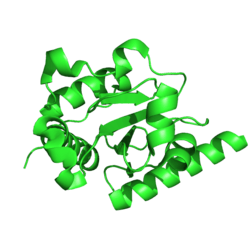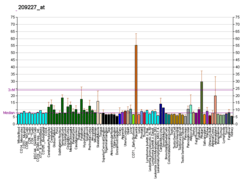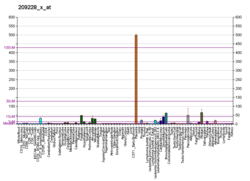TUSC3
Tumor suppressor candidate 3 is a protein that in humans is encoded by the TUSC3 gene.[5][6][7]
This gene is a candidate tumor suppressor gene. It is located within a homozygously deleted region of a metastatic prostate cancer. The gene is expressed in most nonlymphoid human tissues including prostate, lung, liver, and colon. Expression was also detected in many epithelial tumor cell lines. Two transcript variants encoding distinct isoforms have been identified for this gene.[7]
References
- 1 2 3 GRCh38: Ensembl release 89: ENSG00000104723 - Ensembl, May 2017
- 1 2 3 GRCm38: Ensembl release 89: ENSMUSG00000039530 - Ensembl, May 2017
- ↑ "Human PubMed Reference:".
- ↑ "Mouse PubMed Reference:".
- ↑ MacGrogan D, Levy A, Bova GS, Isaacs WB, Bookstein R (Sep 1996). "Structure and methylation-associated silencing of a gene within a homozygously deleted region of human chromosome band 8p22". Genomics. 35 (1): 55–65. doi:10.1006/geno.1996.0322. PMID 8661104.
- ↑ Ishii H, Baffa R, Numata SI, Murakumo Y, Rattan S, Inoue H, Mori M, Fidanza V, Alder H, Croce CM (May 1999). "The FEZ1 gene at chromosome 8p22 encodes a leucine-zipper protein, and its expression is altered in multiple human tumors". Proc Natl Acad Sci U S A. 96 (7): 3928–33. doi:10.1073/pnas.96.7.3928. PMC 22397. PMID 10097140.
- 1 2 "Entrez Gene: TUSC3 tumor suppressor candidate 3".
Further reading
- Pak BJ, Park H, Chang ER, et al. (1998). "Differential display analysis of oxygen-mediated changes in gene expression in first trimester human trophoblast cells". Placenta. 19 (7): 483–8. doi:10.1016/S0143-4004(98)91041-4. PMID 9778121.
- Strausberg RL, Feingold EA, Grouse LH, et al. (2003). "Generation and initial analysis of more than 15,000 full-length human and mouse cDNA sequences". Proc. Natl. Acad. Sci. U.S.A. 99 (26): 16899–903. doi:10.1073/pnas.242603899. PMC 139241. PMID 12477932.
- Kelleher DJ, Karaoglu D, Mandon EC, Gilmore R (2003). "Oligosaccharyltransferase isoforms that contain different catalytic STT3 subunits have distinct enzymatic properties". Mol. Cell. 12 (1): 101–11. doi:10.1016/S1097-2765(03)00243-0. PMID 12887896.
- Anderson NL, Polanski M, Pieper R, et al. (2004). "The human plasma proteome: a nonredundant list developed by combination of four separate sources". Mol. Cell. Proteomics. 3 (4): 311–26. doi:10.1074/mcp.M300127-MCP200. PMID 14718574.
- Colland F, Jacq X, Trouplin V, et al. (2004). "Functional proteomics mapping of a human signaling pathway". Genome Res. 14 (7): 1324–32. doi:10.1101/gr.2334104. PMC 442148. PMID 15231748.
- Gerhard DS, Wagner L, Feingold EA, et al. (2004). "The status, quality, and expansion of the NIH full-length cDNA project: the Mammalian Gene Collection (MGC)". Genome Res. 14 (10B): 2121–7. doi:10.1101/gr.2596504. PMC 528928. PMID 15489334.
- Shibatani T, David LL, McCormack AL, et al. (2005). "Proteomic analysis of mammalian oligosaccharyltransferase reveals multiple subcomplexes that contain Sec61, TRAP, and two potential new subunits". Biochemistry. 44 (16): 5982–92. doi:10.1021/bi047328f. PMID 15835887.
- Rual JF, Venkatesan K, Hao T, et al. (2005). "Towards a proteome-scale map of the human protein-protein interaction network". Nature. 437 (7062): 1173–8. doi:10.1038/nature04209. PMID 16189514.
- Pils D, Horak P, Gleiss A, et al. (2006). "Five genes from chromosomal band 8p22 are significantly down-regulated in ovarian carcinoma: N33 and EFA6R have a potential impact on overall survival". Cancer. 104 (11): 2417–29. doi:10.1002/cncr.21538. PMID 16270321.
- Guervós MA, Marcos CA, Hermsen M, et al. (2007). "Deletions of N33, STK11 and TP53 are involved in the development of lymph node metastasis in larynx and pharynx carcinomas". Cell. Oncol. 29 (4): 327–34. PMID 17641416.
This article is issued from
Wikipedia.
The text is licensed under Creative Commons - Attribution - Sharealike.
Additional terms may apply for the media files.







